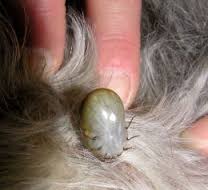 It’s bad enough that ticks live on blood, sometimes feeding for days and sometimes swelling up to 50 times their pre-meal size. But these little bloodsuckers are more than unpleasant. They can also transmit serious diseases like Lyme disease, Rocky Mountain spotted fever, and encephalitis. In rare cases, they can even cause a type of paralysis in which a pet’s hindquarters , and in some cases the entire body, becomes progressively weaker.
It’s bad enough that ticks live on blood, sometimes feeding for days and sometimes swelling up to 50 times their pre-meal size. But these little bloodsuckers are more than unpleasant. They can also transmit serious diseases like Lyme disease, Rocky Mountain spotted fever, and encephalitis. In rare cases, they can even cause a type of paralysis in which a pet’s hindquarters , and in some cases the entire body, becomes progressively weaker.
There are more than 1000 species of tick. They don’t all cause disease, but they all share a penchant for blood. Since there’s no way to tell which ticks are safe and which are worrisome, it’s essential to get them off your dog as soon as possible. A tick has to be on your dog for 48 to 72 hours in order to transmit disease. This gives you a good amount of time to remove it.
A tick isn’t always eager to go however. It feeds by burrowing the head beneath the skin, latching on like a dartlike anchor underneath it’s mouth. The anchor has small teeth that curve backward, which is what makes it so hard to remove. It doesn’t take alot of finesse to pull them loose, but it does take some strength. Here’s what you need to do:
 Immobilize the tick by dabbing it with rubbing alcohol. This sort of anesthetizes the tick, relaxing it so it can be removed more easily. Don’t waste time putting gasoline or kerosene on a tick, and you definitely don’t want to burn it with the end of a match. These strategies don’t work and can injure your dog.
Immobilize the tick by dabbing it with rubbing alcohol. This sort of anesthetizes the tick, relaxing it so it can be removed more easily. Don’t waste time putting gasoline or kerosene on a tick, and you definitely don’t want to burn it with the end of a match. These strategies don’t work and can injure your dog.
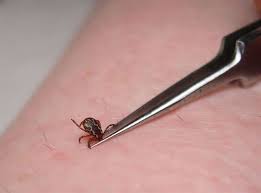 Grasp the tick firmly with a pair of tweezers or hemostats, getting as close to the head as possible. Pull slowly and steadily on the tweezers. Within 5 to 10 seconds you should feel the tick loosening it’s grip. By pulling slowly rather by jerking, the entire head will come out with the body. Pulling too quickly, on the other hand, often causes the head to remain embedded in the skin. The head itself is not infectious, and the normal growth of the skin will push it out in a few days.
Grasp the tick firmly with a pair of tweezers or hemostats, getting as close to the head as possible. Pull slowly and steadily on the tweezers. Within 5 to 10 seconds you should feel the tick loosening it’s grip. By pulling slowly rather by jerking, the entire head will come out with the body. Pulling too quickly, on the other hand, often causes the head to remain embedded in the skin. The head itself is not infectious, and the normal growth of the skin will push it out in a few days.
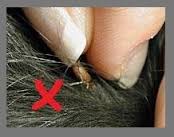 Try not to touch a tick with your bare hands. If you happen to have a small cut on your finger, you could contract anything the tick might be carrying. If you don’t have tweezers and must use your fingers to remove the tick, put some plastic wrap over your fingers, which essentially creates a thin glove or wear a latex glove.
Try not to touch a tick with your bare hands. If you happen to have a small cut on your finger, you could contract anything the tick might be carrying. If you don’t have tweezers and must use your fingers to remove the tick, put some plastic wrap over your fingers, which essentially creates a thin glove or wear a latex glove.
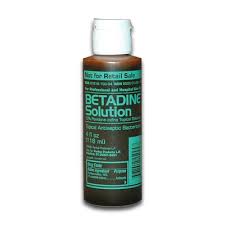 After removing the tick, dab the area with a topical antiseptic, such as Betadine solution. Then get rid of the tick, either by flushing it down the toilet, burning it with a lighter, or by dropping it in a jar of rubbing alcohol or insecticide. You may want to preserve one in alcohol so that your vet or doctor can tell you if it’s the kind of tick that carries any diseases that may be a threat to dog’s in certain regions of the country.
After removing the tick, dab the area with a topical antiseptic, such as Betadine solution. Then get rid of the tick, either by flushing it down the toilet, burning it with a lighter, or by dropping it in a jar of rubbing alcohol or insecticide. You may want to preserve one in alcohol so that your vet or doctor can tell you if it’s the kind of tick that carries any diseases that may be a threat to dog’s in certain regions of the country.
Preventing Problems
Ticks thrive in many parts of the country, and it’s almost impossible to avoid them. If your dog spends any time outdoors, sooner or later they’re going to come home with an unwanted hitchhiker or two. To get rid of ticks before they latch on, here are some tips!
Check them often.
 Unlike fleas, which hop around so fast you can hardly see them, ticks stay in one place which makes them easier to spot. Check for ticks often, especially when your dog has been playing in tall brush or grass.
Unlike fleas, which hop around so fast you can hardly see them, ticks stay in one place which makes them easier to spot. Check for ticks often, especially when your dog has been playing in tall brush or grass.
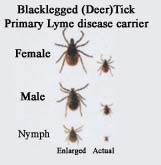 Ticks will latch on anywhere on the body, but they’re especially fond of lightly furred areas-such as around the ears, the belly, between the toes and on the legs. Even though adult ticks are fairly easy to spot-and feel-younger ticks, called nymphs, aren’t much bigger than poppy seeds. The easiest way to spot the younger ticks is to go through your dog’s hair with a fine-toothed comb, looking for little black dots next to the skin. If you find any unattached ticks on your dog’s hair, comb them out with a fine toothed comb and drop them into rubbing alcohol or insecticide.
Ticks will latch on anywhere on the body, but they’re especially fond of lightly furred areas-such as around the ears, the belly, between the toes and on the legs. Even though adult ticks are fairly easy to spot-and feel-younger ticks, called nymphs, aren’t much bigger than poppy seeds. The easiest way to spot the younger ticks is to go through your dog’s hair with a fine-toothed comb, looking for little black dots next to the skin. If you find any unattached ticks on your dog’s hair, comb them out with a fine toothed comb and drop them into rubbing alcohol or insecticide.
Try a combination approach.
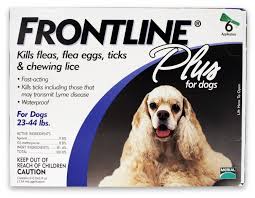 A popular flea medication called Frontline, applied to a dog’s back, also works against ticks. Even when a tick manages to attach, the active ingredient in Frontline will cause it to release it’s grip within 24 hours, before it has time to spread disease. Applying Frontline once a month will give protection against both fleas and ticks.
A popular flea medication called Frontline, applied to a dog’s back, also works against ticks. Even when a tick manages to attach, the active ingredient in Frontline will cause it to release it’s grip within 24 hours, before it has time to spread disease. Applying Frontline once a month will give protection against both fleas and ticks.
Keep them in a sunny spot.
 Dog’s often enjoy napping in shady patches in the yard. Unfortunately, they may have plenty of company. Tick’s aren’t sun worshippers. They go for cool, overgrown places, in shrubbery or tall grasses lining a yard. Although playing out in direct sunlight isn’t advisable for your dog, those areas that get some full sun during the day are where you want them to stay even after the sun has moved on. Your dog is less likely to pick up a tick there than in the underbrush.
Dog’s often enjoy napping in shady patches in the yard. Unfortunately, they may have plenty of company. Tick’s aren’t sun worshippers. They go for cool, overgrown places, in shrubbery or tall grasses lining a yard. Although playing out in direct sunlight isn’t advisable for your dog, those areas that get some full sun during the day are where you want them to stay even after the sun has moved on. Your dog is less likely to pick up a tick there than in the underbrush.
 Keep up with lawn care.
Keep up with lawn care.
Grass that’s mowed often traps less moisture and gets much more sun, which will help keep ticks under control. Don’t forget to trim long grass near trees and fences, which often escapes the mower’s blades. Don’t put out the welcome mat for ticks. Clear away all of your underbrush.
 Get rid of rodents.
Get rid of rodents.
Young ticks initially bite rodents before making the transition to dogs. Keeping your yard rodent free will also help in the battle against ticks. Control rodents by removing rocks, brush, woodpiles and other debris that provides places for them to hide. Also, move bird feeders away from the house because the seeds may attract rodents along with the birds.
 Take care on outings.
Take care on outings.
When your taking your dog hiking, protect her with a flea and tick spray containing pyrethrins, or my preference, an all natural alternative. Or, spray them within a minute of your return then check them all over.
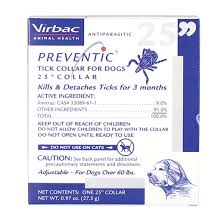 Protect them with a collar.
Protect them with a collar.
Try a tick collar containing an active ingredient called amitraz, which repels ticks. You can use these collars in conjunction with other tick control methods. Most collars are safe around children, unlike some combination tick and flea collars.
Homeopathic remedy
The remedy Ledum works well for puncture wounds and in particular to counteract tick borne diseases such as Rocky Mountain spotted fever or Lyme disease.
Use Ledum if you see any sensitivity or swelling at the site where a tick has been removed. Most of the time there is no reaction. However, if you live in an area where there is a known prevalence of tick disease, Ledum is an effective preventative measure that can be used during the height of tick season.
Dosage

Give Ledum 30C once after removal of the tick. For general prevention, give every five to seven days during tick season.
Essential Oils


There are several essential oils that are known to repel ticks and other pesky insects such as lemongrass, lavender, citronella, eucalyptus and cedarwood. Some oils need to be diluted with a carrier oil so be sure to read the instructions.
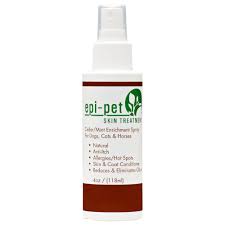 Epi Pet carries a conditioning skin spray that contains cedar and lavender. This all natural spray is helpful in the prevention of fleas and ticks. It can be sprayed on your pets coat either wet or dry. It also has a pleasant aroma.
Epi Pet carries a conditioning skin spray that contains cedar and lavender. This all natural spray is helpful in the prevention of fleas and ticks. It can be sprayed on your pets coat either wet or dry. It also has a pleasant aroma.
Veterinarians Guide to Natural Remedies
Vets on Call
t






